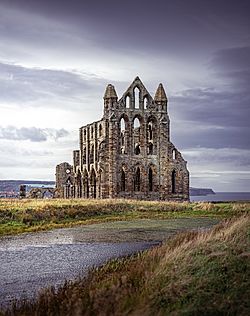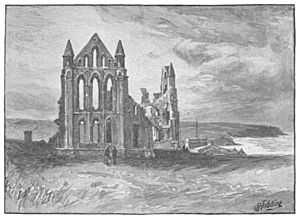Whitby Abbey facts for kids
 |
|
| Monastery information | |
|---|---|
| Order | Benedictine |
| Established | 657 AD |
| Disestablished | 1538 |
| Diocese | Diocese of York |
| People | |
| Founder(s) | 1. Oswy 2. Prior Reinfrid |
| Site | |
| Location | Whitby, North Yorkshire, England |
| Coordinates | 54.4883 -0.6075 |
| Visible remains | substantial |
| Public access | yes |
Whitby Abbey was an important Christian monastery built a long time ago, in the 7th century. It later became a Benedictine abbey. This amazing church stood high on a cliff, looking out over the North Sea in Whitby, England. It was a key place in the old kingdom of Northumbria.
The abbey and its lands were taken by King Henry VIII between 1536 and 1545. This happened during a time called the Dissolution of the Monasteries, when many monasteries in England were closed.
Even after it became a ruin, sailors used the abbey as a landmark to guide their ships. Today, the large ruins of the church are a Grade I Listed building. This means they are very important and protected. English Heritage looks after the site, and there's a museum in Cholmley House nearby.
Whitby Abbey is also famous because it appears in Bram Stoker’s scary book, Dracula (1897). In the story, Count Dracula arrives in Whitby as a large dog. He runs up the 199 steps to the graveyard of St Mary's Church, which is right next to the abbey ruins. The abbey is also described in the diary of a character named Mina Harker.
Contents
The First Monastery: Streoneshalh
The very first monastery here was started in 657 AD. It was built by Oswiu, who was the King of Northumbria during the Anglo-Saxon era. He called it Streoneshalh, which was the old name for Whitby.
King Oswiu chose Lady Hilda to be the first leader, or abbess, of the monastery. She was already the abbess of Hartlepool Abbey. The name Streoneshalh might mean Fort Bay or Tower Bay. Some people think it refers to an old Roman settlement that was once there. However, this has never been proven.
This monastery was a double monastery, meaning it had both monks and nuns. A famous Northumbrian poet named Cædmon lived there from 614 to 680.
In 664, an important meeting called the Synod of Whitby took place at the monastery. The main question was whether the church in Northumbria should follow Celtic Christian traditions or Roman practices. This included how to figure out the date of Easter and the style of a monk's haircut (called a tonsure). With King Oswiu's support, they decided to follow the Roman ways.
Sadly, the Streoneshalch monastery was destroyed by Danes in attacks between 867 and 870. It remained empty for over 200 years.
Whitby Abbey Rebuilt
Later, a soldier named Reinfrid, who fought for William the Conqueror, became a monk. He came to Streoneshalh, which was then known as Prestebi or Hwitebi. Hwitebi means "white settlement" in an old language called Old Norse.
Reinfrid asked William de Percy for land. De Percy gave him the ruined monastery of St. Peter to start a new one. This new monastery followed the Benedictine rule. Serlo de Percy, William's brother, joined Reinfrid.
The Benedictine abbey grew and became a busy center for learning for many centuries. However, this second monastery was also destroyed by King Henry VIII in 1540 during the Dissolution of the Monasteries.
After its destruction, Sir Richard Cholmley bought the abbey. It stayed in the Cholmley family for a long time. In 1920, the Strickland family, who were descendants of the Cholmleys, gave it to the UK government. Today, English Heritage owns and takes care of the ruins.
In December 1914, Whitby Abbey was attacked by German warships during World War I. The ships, called Von der Tann and Derfflinger, fired shells at the coast. The abbey buildings were badly damaged during this ten-minute attack.
Whitby Abbey in Dracula
Bram Stoker's famous 1897 novel Dracula uses Whitby Abbey as an important setting. In the story, Count Dracula arrives in Whitby as a large, dog-like creature. He comes ashore at the headland and runs up the 199 steps to the graveyard of St Mary's Church. This church is right in the shadow of the Whitby Abbey ruins.
The abbey is also described in the diary of a character named Mina Harker. She writes:
Right over the town is the ruin of Whitby Abbey, which was sacked by the Danes, and which is the scene of part of "Marmion," where the girl was built up in the wall. It is a most noble ruin, of immense size, and full of beautiful and romantic bits; there is a legend that a white lady is seen in one of the windows.
Important People Buried Here
Many important people were buried at Whitby Abbey, including:
- Hilda of Whitby
- Bosa of York
- Edwin of Deira, a king and saint
- Oswiu of Northumbria, a king
- Eahlfrith, King Oswiu's widow and an abbess of Whitby
- Ælfflæd of Whitby, daughter of Oswiu and Eanflæd, also an abbess
- Joscelin of Louvain
- Sir William de Percy, 1st Baron Percy (died around 1096), a Norman baron and Crusader
- Sir Richard de Percy, 5th Baron Percy (1166–1243), who signed the Magna Carta
|
See also
 In Spanish: Abadía de Whitby para niños
In Spanish: Abadía de Whitby para niños





